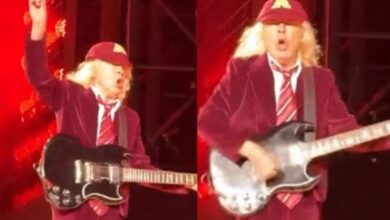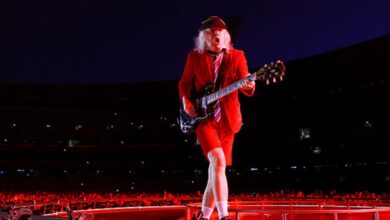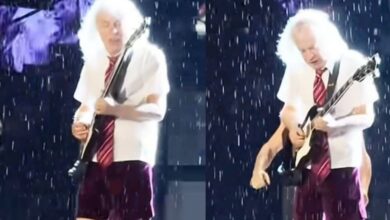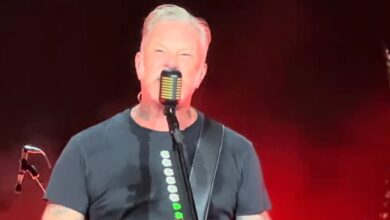AC/DC Detonate the MCG: “Back in Black” Erupts in a Stadium-Shaking Melbourne Night
On November 16, 2025, Melbourne felt like a city bracing for impact. All day long, trains and trams emptied wave after wave of fans toward the Melbourne Cricket Ground, each wearing black T-shirts, vintage tour jackets, and red devil horns that glowed like tiny sparks across the streets. This was AC/DC’s second night at the MCG, a long-awaited return to their home soil after years away from Australian stadiums. Expectations were already sky-high after reports that the first show had literally shaken the ground, and the atmosphere around the arena carried a sense of wild anticipation.
Inside the stadium, the energy swelled with every minute leading up to showtime. More than 80,000 people packed the stands and the grass, talking excitedly about what might happen on this final Melbourne night. The stage setup loomed like a metal fortress, its massive screens, floodlights, and catwalks suggesting an avalanche of sound and spectacle ahead. Fans knew the setlist from the first show, but that didn’t reduce the excitement—if anything, it heightened it. Everyone was waiting for the moment when one of rock’s most iconic riffs would rip through the night sky.
When the lights snapped to black, an earthquake-like roar burst from the crowd. Red lighting crawled across the stage, forming silhouettes of the band as they took their positions. The show opened at full speed, and the force of that first performance hit hard. But nothing compared to what came next. As the opening song ended and fans barely had time to inhale, the stadium’s sound system erupted with four of the most recognizable notes in rock history. The opening riff of “Back in Black” sliced through the night like lightning.
The reaction from the crowd was instant and explosive. Tens of thousands screamed as if the sound reached some primal memory stored deep in every fan’s heart. Those opening notes, dry and punchy, were enough to make people jump out of their seats before Brian Johnson even stepped to the microphone. In that moment, the MCG transformed from a stadium into a living, breathing monument to hard rock. The song wasn’t nostalgia—it felt brand new, as powerful now as it was when it reshaped music decades earlier.
Angus Young took command the second the riff started. At 70 years old, he moved with the agility and fire of a performer half his age. His Gibson SG hung low, the spotlight reflecting off the polished wood as he stalked the edge of the runway. Every chord he hit was sharp and deliberate, giving the legendary riff a crushing weight that reverberated through the stands. Fans in the front rows reached out toward him, reacting to every step of his signature duck-walk as if he were a myth brought to life.
Brian Johnson’s entrance hit like a punch of electricity. His rasp, aged yet powerful, wrapped perfectly around each syllable of “Back in Black.” He didn’t chase the impossible high notes of decades past—he sang with grit, swagger, and a lived-in authority that felt tailor-made for a 2025 stadium crowd. Each time he shouted the chorus, the audience screamed it back with hurricane-level force, proving that the connection between band and fanbase had not dimmed in the slightest.
From the upper tiers of the MCG, the stadium looked like a massive sea of movement. Thousands of bodies bounced in perfect rhythm, arms lifting on the snare hits and voices rising as one. The concrete beneath everyone’s feet vibrated with each stomp, creating a physical sensation that many fans later described as unforgettable. “Back in Black” didn’t just fill the venue—it consumed it, turning eighty thousand individuals into a single unified force fueled by adrenaline and decades of devotion.
The mix of generations in the audience was part of what made the moment magical. Older fans who had lived through the Bon Scott years shared the same overwhelming excitement as teenagers hearing the song live for the first time. Families stood shoulder to shoulder, singing together without hesitation. Friends linked arms and shouted the lyrics into one another’s faces. Even strangers exchanged knowing smiles, realizing they were all witnessing something that didn’t come around often, perhaps only once in a lifetime.
As the verse gave way to the iconic breakdown, Angus stepped forward to deliver the solo. The screens zoomed in on his hands, capturing every flicker of movement as he hammered and bent strings with laser precision. His energy intensified as he sprinted down the runway mid-solo, the crowd erupting with every step. Even from the farthest seats, his presence was unmistakable—a small figure with an enormous aura, commanding the biggest stadium in Australia with effortless authority.
“Back in Black” carries a deep legacy, and that legacy felt alive in every corner of the MCG. The song is both a tribute and a resurrection—written to honor Bon Scott yet becoming the defining track that launched AC/DC into global superstardom. Hearing it live in 2025, with two original members still leading the charge, made the experience feel historic. It wasn’t just a reminder of where the band came from—it was proof that their fire still burned bright enough to light up an entire city.
As the final chorus hit, the stadium turned into a roar so loud it felt physical. Fans screamed with everything they had left, filling the open night air above the MCG with a massive wall of sound. When the last “I’m back!” punched through the speakers and the band slammed into the closing chords, the explosion of noise that followed was overwhelming. People yelled, clapped, and jumped to the point where the stadium floor felt alive under their feet.
For a moment after the song ended, there was a stunned silence—a collective breath held as people tried to process what they had just witnessed. Then the cheering started again, louder than before, as fans realized they had just experienced one of the greatest performances of one of rock’s greatest songs. AC/DC wasted no time, rolling straight into the next track with the same intensity, refusing to let the energy dip for even a second.
As the concert pushed on, “Back in Black” remained the emotional centerpiece of the night. Whether fans were hearing “Thunderstruck,” “Hells Bells,” or “You Shook Me All Night Long,” they kept returning to that moment when the iconic riff first erupted. It became the heartbeat of the entire show, the song people couldn’t stop talking about during interludes or between choruses.
Hours later, as fans exited the stadium into the cool November air, the night still clung to them. People hummed the riff while waiting for trams and trains. Others replayed shaky phone videos of the solo, smiling at the memory. Conversations overlapped with phrases like “unbelievable,” “the best ever,” and “I’ll never forget that.” Melbourne felt electrified long after the amplifiers had been silenced.
In the following days, people across social media and fan forums declared the November 16 performance one of the band’s greatest in recent years. The power, precision, and emotion of “Back in Black” stood out as the moment the entire stadium locked into a single pulse. For Melbourne, that night wasn’t just a concert—it was a collision of legacy, energy, and history. And at its center stood one song, four notes, and a band that proved they were still very much back.
Related :





